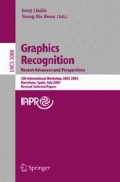Abstract
We are developing a recognition system which aims to convert a sequence of illustrations in origami drill books into a 3D animation, with a view to providing an easy way for learning and enjoying origami art. As a part of this work, this paper proposes a method that recognizes a target graph corresponding to an origami shape from an origami illustration image. The target graph, called ISG (Ideal Shape Graphs), generated from an internal model that maintains 3D information about changes of origami states during the interpretation for the whole folding process. In order to understand the folding operation applied to the origami at each step, an ISG of the origami generated at current step has to be matched with the image of the origami illustration at the next step, to find whether there exists a similar graph within it. The image of the origami is usually very noisy. Since the computational cost to do this work is prohibitive even for problems of moderate sizes, we adopt a genetic algorithm in conjunction with hill climbing search technique to reduce the complexity. Experimental results show that good solutions can be found with lower cost using our method.
Access this chapter
Tax calculation will be finalised at checkout
Purchases are for personal use only
Preview
Unable to display preview. Download preview PDF.
References
Okamura, T.: My Origami World (2000), http://www.oklab.com/origami/ori_wold.html
Agui, T., Takeda, T., Nakajima, M.: An Origami Playing Folds by Computer. Computer Vision, Graphics and Image Processing 24(6), 244–258 (1983)
Miyazaki, S., Yasuda, T., Yokoi, S., Toriwaki, J.: An Origami Playing Simulator in the Virtual Space. J. Visualization and Computer Animation 7(6), 25–42 (1996)
Kato, J., Watanabe, T., et al.: A Model-based Approach for Recognizing Folding Process of Origami. In: Proc. of 14th Int’l. Conference on Pattern Recognition, pp. 1808–1811 (1998)
Kato, J., Watanabe, T., Hase, H., Nakayama, T.: Understanding Illustrations of Origami Drill Books. Trans. on Information Processing Society of Japan 41(6), 1857–1873 (2000)
Shimanuki, H., Kato, J., Watanabe, T.: Constituting Feasible Folding Operations Using Incomplete Crease Information. In: Proc. of IAPR Workshop on Machine Vision Applications, Nara, Japan, pp. 67–71 (2002)
Goldberg, D.E.: Genetic Algorithms in Search, Optimization, and Machine Learning. Addison-Wesley, Reading (1989)
Author information
Authors and Affiliations
Editor information
Editors and Affiliations
Rights and permissions
Copyright information
© 2004 Springer-Verlag Berlin Heidelberg
About this paper
Cite this paper
Kato, J., Suzuki, T., Watanabe, T. (2004). Recognition of Target Graphs from Images Using a Genetic Algorithm with Hill Climbing Searching. In: Lladós, J., Kwon, YB. (eds) Graphics Recognition. Recent Advances and Perspectives. GREC 2003. Lecture Notes in Computer Science, vol 3088. Springer, Berlin, Heidelberg. https://doi.org/10.1007/978-3-540-25977-0_22
Download citation
DOI: https://doi.org/10.1007/978-3-540-25977-0_22
Publisher Name: Springer, Berlin, Heidelberg
Print ISBN: 978-3-540-22478-5
Online ISBN: 978-3-540-25977-0
eBook Packages: Springer Book Archive

